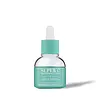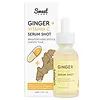What's inside
What's inside
 Key Ingredients
Key Ingredients

 Benefits
Benefits

 Concerns
Concerns

 Ingredients Side-by-side
Ingredients Side-by-side

Water
Skin ConditioningEthoxydiglycol
HumectantAscorbic Acid
AntioxidantButylene Glycol
HumectantGlycerin
HumectantKojic Acid
AntioxidantPhenoxyethanol
PreservativeCitrus Aurantium Dulcis Peel Oil
MaskingFerulic Acid
AntimicrobialSalicylic Acid
MaskingTriethanolamine
BufferingSaxifraga Sarmentosa Extract
Skin ConditioningVitis Vinifera Fruit Extract
Skin ConditioningLaureth-23
CleansingCamellia Sinensis Leaf Extract
AntimicrobialTocopherol
AntioxidantAlchemilla Vulgaris Flower/Leaf/Stem Extract
AstringentMalva Sylvestris Flower/Leaf/Stem Extract
Skin ConditioningMentha Piperita Leaf Extract
Skin ConditioningPrimula Veris Flower Extract
Skin ConditioningVeronica Officinalis Flower/Leaf/Stem Extract
AstringentMelissa Officinalis Leaf Extract
Skin ConditioningSodium Metabisulfite
AntioxidantSodium Sulfite
PreservativeMorus Alba Root Extract
BleachingScutellaria Baicalensis Root Extract
AstringentCentella Asiatica Extract
CleansingDisodium EDTA
Achillea Millefolium Flower/Leaf/Stem Extract
Skin ConditioningAlpha-Arbutin
AntioxidantHydrolyzed Hyaluronic Acid
HumectantNiacinamide
SmoothingPanthenol
Skin ConditioningSodium PCA
HumectantDiethanolamine
BufferingWater, Ethoxydiglycol, Ascorbic Acid, Butylene Glycol, Glycerin, Kojic Acid, Phenoxyethanol, Citrus Aurantium Dulcis Peel Oil, Ferulic Acid, Salicylic Acid, Triethanolamine, Saxifraga Sarmentosa Extract, Vitis Vinifera Fruit Extract, Laureth-23, Camellia Sinensis Leaf Extract, Tocopherol, Alchemilla Vulgaris Flower/Leaf/Stem Extract, Malva Sylvestris Flower/Leaf/Stem Extract, Mentha Piperita Leaf Extract, Primula Veris Flower Extract, Veronica Officinalis Flower/Leaf/Stem Extract, Melissa Officinalis Leaf Extract, Sodium Metabisulfite, Sodium Sulfite, Morus Alba Root Extract, Scutellaria Baicalensis Root Extract, Centella Asiatica Extract, Disodium EDTA, Achillea Millefolium Flower/Leaf/Stem Extract, Alpha-Arbutin, Hydrolyzed Hyaluronic Acid, Niacinamide, Panthenol, Sodium PCA, Diethanolamine
Water
Skin ConditioningGlycerin
HumectantMethyl Gluceth-20
HumectantCeramide AP
Skin Conditioning1,2-Hexanediol
Skin ConditioningPropanediol
SolventZingiber Officinale Root Extract
MaskingAscorbic Acid
AntioxidantCorallina Officinalis Extract
Skin ConditioningCurcuma Longa Root Extract
MaskingOcimum Sanctum Leaf Extract
Skin ConditioningChondrus Crispus Extract
Skin ConditioningSaccharum Officinarum Extract
MoisturisingMelia Azadirachta Flower Extract
Skin ConditioningCholeth-24
EmulsifyingCarbomer
Emulsion StabilisingTromethamine
BufferingXanthan Gum
EmulsifyingEthylhexylglycerin
Skin ConditioningDisodium EDTA
Melia Azadirachta Leaf Extract
Skin ConditioningButylene Glycol
HumectantCyanocobalamin
Skin ConditioningLavandula Angustifolia Oil
MaskingWater, Glycerin, Methyl Gluceth-20, Ceramide AP, 1,2-Hexanediol, Propanediol, Zingiber Officinale Root Extract, Ascorbic Acid, Corallina Officinalis Extract, Curcuma Longa Root Extract, Ocimum Sanctum Leaf Extract, Chondrus Crispus Extract, Saccharum Officinarum Extract, Melia Azadirachta Flower Extract, Choleth-24, Carbomer, Tromethamine, Xanthan Gum, Ethylhexylglycerin, Disodium EDTA, Melia Azadirachta Leaf Extract, Butylene Glycol, Cyanocobalamin, Lavandula Angustifolia Oil
Ingredients Explained
These ingredients are found in both products.
Ingredients higher up in an ingredient list are typically present in a larger amount.
Ascorbic Acid is is pure Vitamin C. This form makes up the largest amount of vitamin C found naturally in our skin.
Not only is vitamin C great for your overall health and immune system, it also has plenty of benefits on your skin.
Vitamin C is best used for brightening skin. It improves dark spots, acne scars, and hyperpigmentation. This is because it blocks the process of skin darkening when exposed to UV.
Remember: Vitamin C should not replace sunscreen!
Your skin uses vitamin C to build collagen. Collagen is one key component in having a strong skin barrier and plump skin. Vitamin C also plays a role in regulating collagen, thus making it effective in improving wrinkles and fine lines.
Ascorbic acid shows potent antioxidant activity. As an antioxidant, it helps fight free-radicals. Free-radicals are molecules that may damage your skin cells. These antioxidants also protect skin against UV damage.
The best formulations include Vitamin E and/or ferulic acid. These two ingredients help stabilize and provide a boost in the benefits of ascorbic acid. This is because ascorbic acid becomes unstable when exposed to UV and air. In fact, you can tell your ascorbic acid has oxidized when it turns an orange-yellow color.
Ascorbic acid is generally compatible with other ingredients. However, using ascorbic acid with other active ingredients might cause irritation. Two ingredients: copper ions and benzoyl peroxide, will inactivate ascorbic acid completely.
Read more about other types of Vitamin C:
Foods rich with vitamin C include oranges, strawberries, broccoli, bell peppers, and more. When consuming Vitamin C, your skin receives a portion of the nutrients.
Learn more about Ascorbic AcidButylene Glycol (or BG) is used within cosmetic products for a few different reasons:
Overall, Butylene Glycol is a safe and well-rounded ingredient that works well with other ingredients.
Though this ingredient works well with most skin types, some people with sensitive skin may experience a reaction such as allergic rashes, closed comedones, or itchiness.
Learn more about Butylene GlycolDisodium EDTA plays a role in making products more stable by aiding other preservatives.
It is a chelating agent, meaning it neutralizes metal ions that may be found in a product.
Disodium EDTA is a salt of edetic acid and is found to be safe in cosmetic ingredients.
Learn more about Disodium EDTAGlycerin is already naturally found in your skin. It helps moisturize and protect your skin.
A study from 2016 found glycerin to be more effective as a humectant than AHAs and hyaluronic acid.
As a humectant, it helps the skin stay hydrated by pulling moisture to your skin. The low molecular weight of glycerin allows it to pull moisture into the deeper layers of your skin.
Hydrated skin improves your skin barrier; Your skin barrier helps protect against irritants and bacteria.
Glycerin has also been found to have antimicrobial and antiviral properties. Due to these properties, glycerin is often used in wound and burn treatments.
In cosmetics, glycerin is usually derived from plants such as soybean or palm. However, it can also be sourced from animals, such as tallow or animal fat.
This ingredient is organic, colorless, odorless, and non-toxic.
Glycerin is the name for this ingredient in American English. British English uses Glycerol/Glycerine.
Learn more about GlycerinWater. It's the most common cosmetic ingredient of all. You'll usually see it at the top of ingredient lists, meaning that it makes up the largest part of the product.
So why is it so popular? Water most often acts as a solvent - this means that it helps dissolve other ingredients into the formulation.
You'll also recognize water as that liquid we all need to stay alive. If you see this, drink a glass of water. Stay hydrated!
Learn more about Water